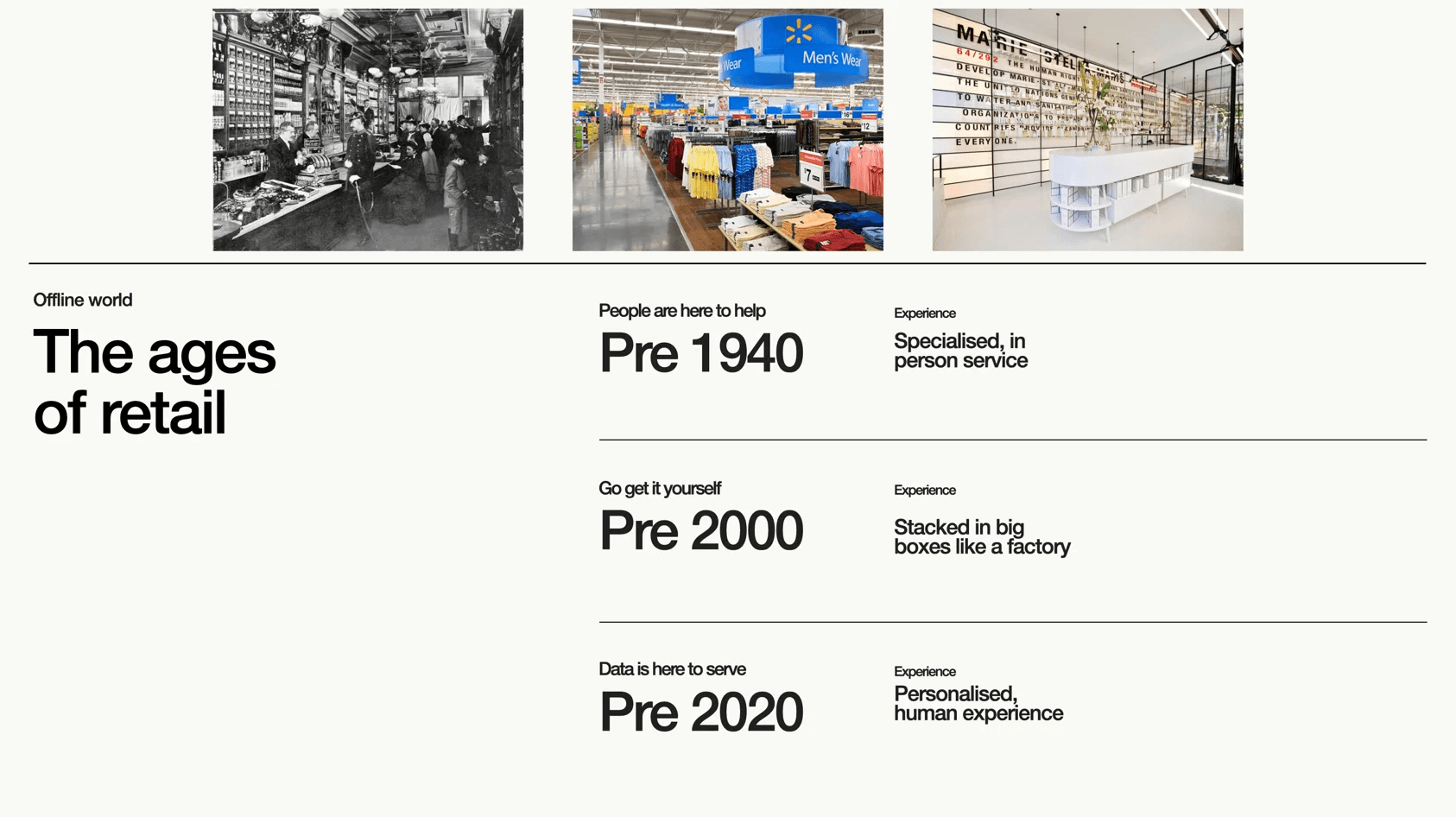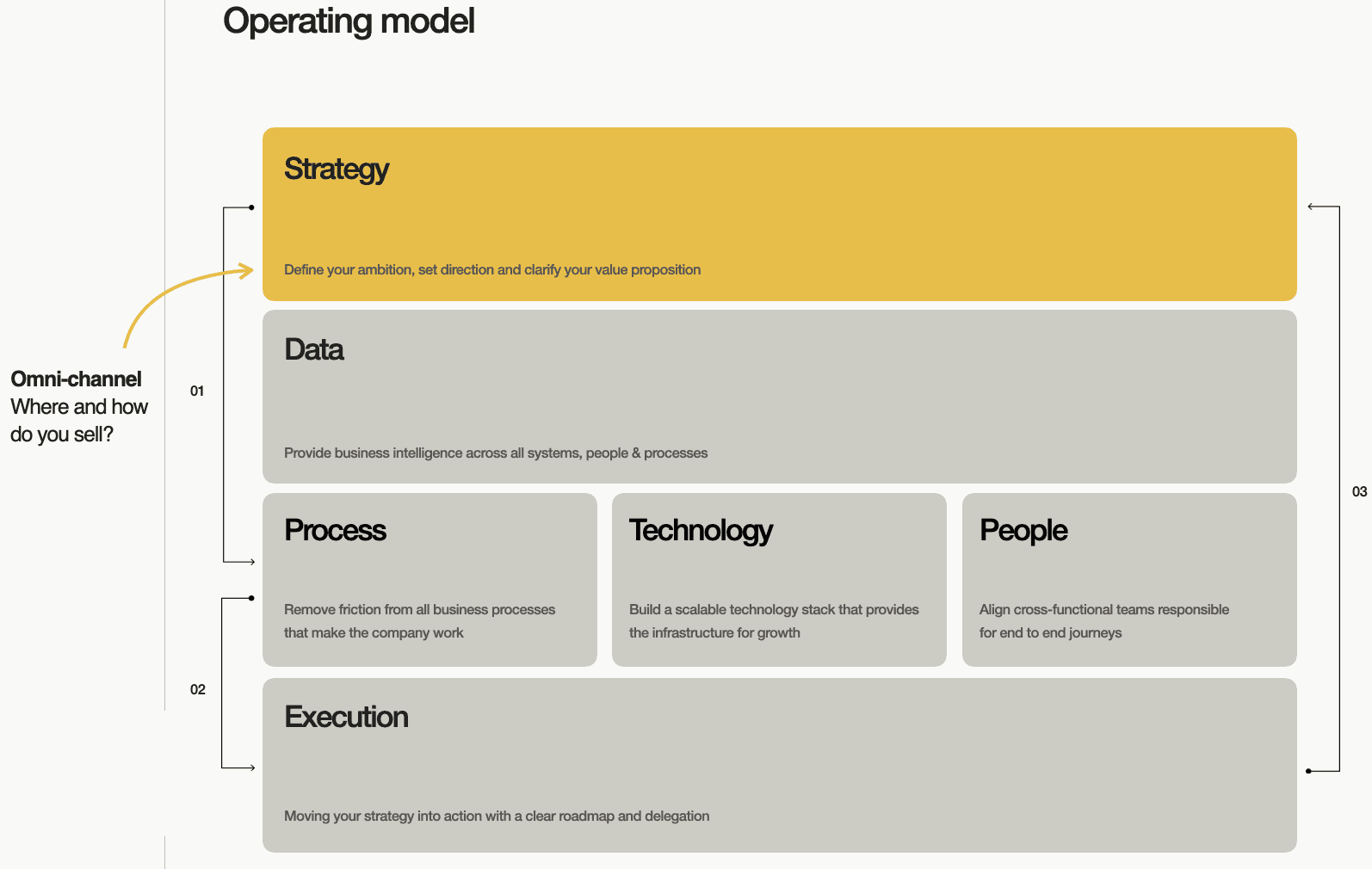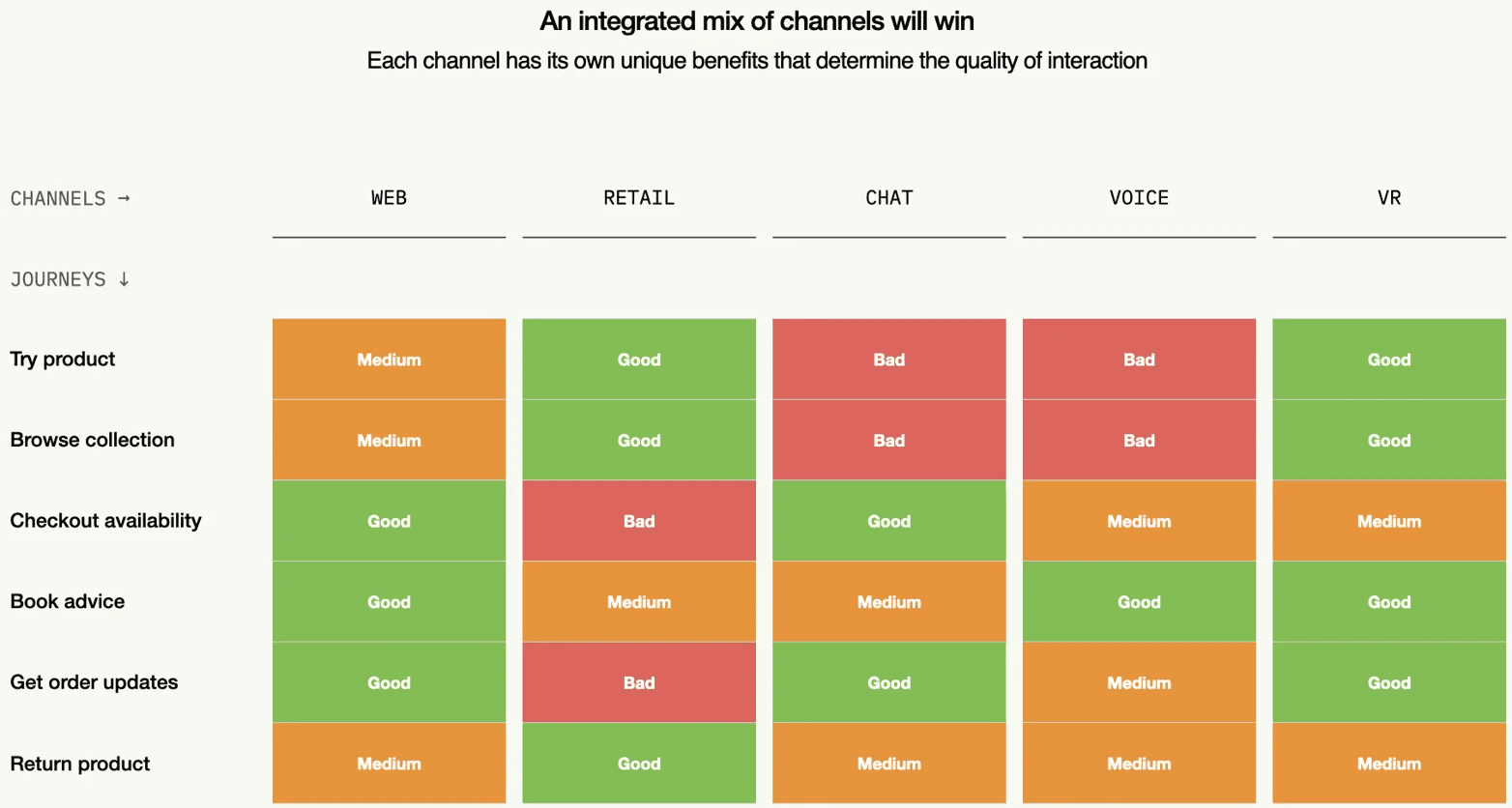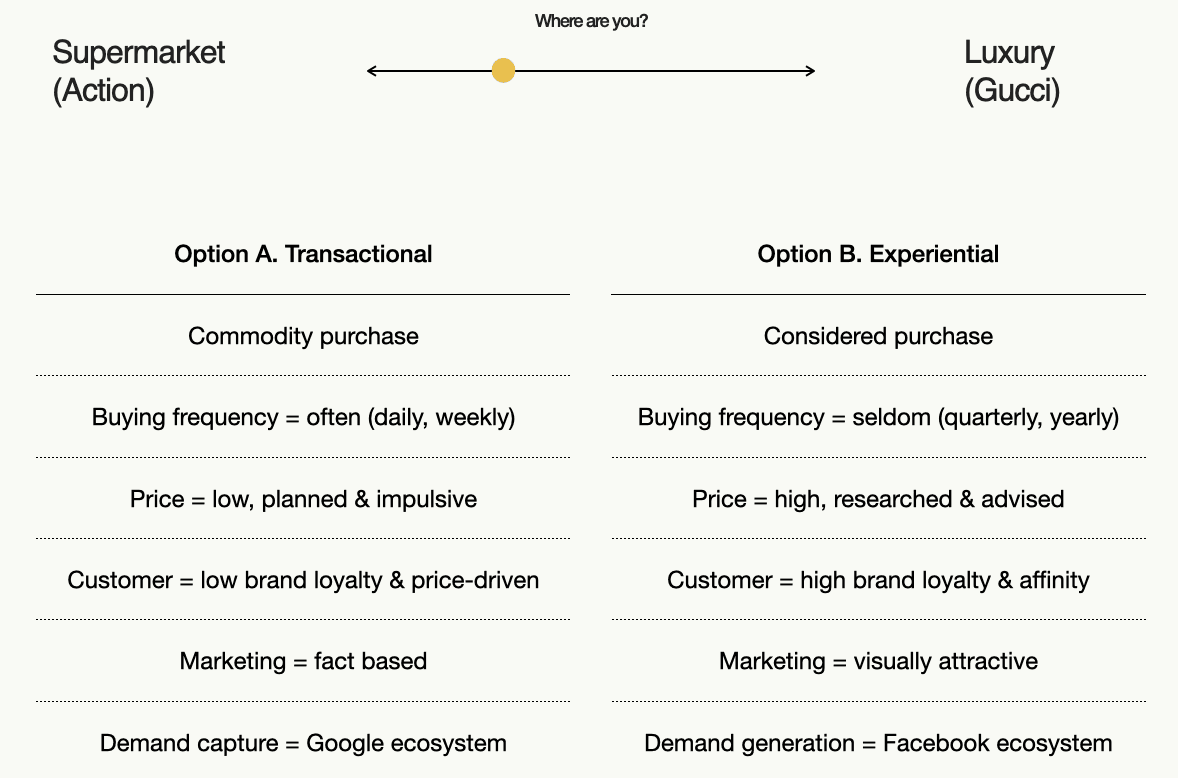


Jul 12, 2023
Jul 12, 2023
Webinar key takeaways | Mastering omnichannel in e-commerce
Webinar key takeaways | Mastering omnichannel in e-commerce

Written by
Written by
Aurelija Vycaite
Aurelija Vycaite
Webinars
A recent webinar by our co-founder Jons Janssens on mastering omnichannel in e-commerce provided many insights and frameworks for building an omnichannel strategy for consumer brands. Today, we share the key takeaways from the session.
If you want to watch the recording of the full webinar "Mastering omnichannel in e-commerce", find it here.

A recent webinar by our co-founder Jons Janssens on mastering omnichannel in e-commerce provided many insights and frameworks for building an omnichannel strategy for consumer brands. Today, we share the key takeaways from the session.
If you want to watch the recording of the full webinar "Mastering omnichannel in e-commerce", find it here.

The context: channels between you and your customer will continue to evolve
The context: channels between you and your customer will continue to evolve
Technology breakthroughs, customer demands, urbanization, and many other socioeconomic factors have been causing consumer brands to wrestle with the constant shift of channels that connect them to their customers.
The history of retail demonstrates how the shopping experience has dramatically changed over the years: from personalized shopping experiences in the early 20th century to the big box retailers offering vast product variety at lower prices at the end of the millennium.
Not a long time ago, amid the pandemic, many were questioning the destiny of traditional retail and whether brick-and-mortar would remain relevant with the rapid surge and adoption of online shopping.
However, what we actually see happening today is the amalgamation of the physical and digital retail worlds. Neither online nor offline shopping is superior. The winning customer experience brings together online benefits to in-store shopping and vice versa. This is what we call the rise of omnichannel retail. And it is evolving more rapidly than ever before.

Today, leading brands (especially in the luxury, premium industries) aim to improve the customer experience by leveraging data from online interactions to provide tailored experiences within their physical retail stores. Imagine stepping into a store and being promptly notified about a discount on an item from your online wishlist or getting informed about a complimentary product for the one you already have.
Although such experience seems advanced, it is definitely not the final point of retail evolution. Expect every new technology innovation (i.e., AI, obviously) to have a bigger or smaller impact on the opportunities for your customer experience enhancement.
Technology breakthroughs, customer demands, urbanization, and many other socioeconomic factors have been causing consumer brands to wrestle with the constant shift of channels that connect them to their customers.
The history of retail demonstrates how the shopping experience has dramatically changed over the years: from personalized shopping experiences in the early 20th century to the big box retailers offering vast product variety at lower prices at the end of the millennium.
Not a long time ago, amid the pandemic, many were questioning the destiny of traditional retail and whether brick-and-mortar would remain relevant with the rapid surge and adoption of online shopping.
However, what we actually see happening today is the amalgamation of the physical and digital retail worlds. Neither online nor offline shopping is superior. The winning customer experience brings together online benefits to in-store shopping and vice versa. This is what we call the rise of omnichannel retail. And it is evolving more rapidly than ever before.

Today, leading brands (especially in the luxury, premium industries) aim to improve the customer experience by leveraging data from online interactions to provide tailored experiences within their physical retail stores. Imagine stepping into a store and being promptly notified about a discount on an item from your online wishlist or getting informed about a complimentary product for the one you already have.
Although such experience seems advanced, it is definitely not the final point of retail evolution. Expect every new technology innovation (i.e., AI, obviously) to have a bigger or smaller impact on the opportunities for your customer experience enhancement.
Technology breakthroughs, customer demands, urbanization, and many other socioeconomic factors have been causing consumer brands to wrestle with the constant shift of channels that connect them to their customers.
The history of retail demonstrates how the shopping experience has dramatically changed over the years: from personalized shopping experiences in the early 20th century to the big box retailers offering vast product variety at lower prices at the end of the millennium.
Not a long time ago, amid the pandemic, many were questioning the destiny of traditional retail and whether brick-and-mortar would remain relevant with the rapid surge and adoption of online shopping.
However, what we actually see happening today is the amalgamation of the physical and digital retail worlds. Neither online nor offline shopping is superior. The winning customer experience brings together online benefits to in-store shopping and vice versa. This is what we call the rise of omnichannel retail. And it is evolving more rapidly than ever before.

Today, leading brands (especially in the luxury, premium industries) aim to improve the customer experience by leveraging data from online interactions to provide tailored experiences within their physical retail stores. Imagine stepping into a store and being promptly notified about a discount on an item from your online wishlist or getting informed about a complimentary product for the one you already have.
Although such experience seems advanced, it is definitely not the final point of retail evolution. Expect every new technology innovation (i.e., AI, obviously) to have a bigger or smaller impact on the opportunities for your customer experience enhancement.
Technology breakthroughs, customer demands, urbanization, and many other socioeconomic factors have been causing consumer brands to wrestle with the constant shift of channels that connect them to their customers.
The history of retail demonstrates how the shopping experience has dramatically changed over the years: from personalized shopping experiences in the early 20th century to the big box retailers offering vast product variety at lower prices at the end of the millennium.
Not a long time ago, amid the pandemic, many were questioning the destiny of traditional retail and whether brick-and-mortar would remain relevant with the rapid surge and adoption of online shopping.
However, what we actually see happening today is the amalgamation of the physical and digital retail worlds. Neither online nor offline shopping is superior. The winning customer experience brings together online benefits to in-store shopping and vice versa. This is what we call the rise of omnichannel retail. And it is evolving more rapidly than ever before.

Today, leading brands (especially in the luxury, premium industries) aim to improve the customer experience by leveraging data from online interactions to provide tailored experiences within their physical retail stores. Imagine stepping into a store and being promptly notified about a discount on an item from your online wishlist or getting informed about a complimentary product for the one you already have.
Although such experience seems advanced, it is definitely not the final point of retail evolution. Expect every new technology innovation (i.e., AI, obviously) to have a bigger or smaller impact on the opportunities for your customer experience enhancement.
The challenge: omnichannel may be more complex than you expect
The challenge: omnichannel may be more complex than you expect
Building a truly seamless, convenient omnichannel customer experience brings about challenges not everyone would expect. The bigger your business scale (number of markets, retail network, customer and product segments), the more difficult taming it will be.
To this equation you should also add the increasingly high standard of customer expectations. Today, these expectations are not dictated by your direct competitors anymore. Instead, the current standards are determined by companies such as Uber, Google, or Cool Blue, particularly here in the Netherlands. It is them who decide what your customer will expect when searching for a product, placing an order, or receiving customer support. Inevitably, such companies heavily invest in enriching both the digital and in-store experience and bolstering their technology infrastructure.
Therefore, the crucial point here is being ready for constant change and the ability to manage increasingly complex retail and technical infrastructures. To stay ahead of the curve, brands must react promptly to emerging technologies and evolving customer demands. As such, it isn't just your technology stack that needs to be agile, adaptable, and flexible, but also your team and, indeed, your entire business operating model, which should demonstrate modularity and flexibility, allowing for efficient adjustments to continually evolving channels, seamless integration of new ones, and frictionless incorporation of these channels into the existing framework.

Having highlighted the challenges of creating a successful omnichannel experience, we now move on to discussing some key takeaways from the webinar. These points focus on understanding the customer's journey across different channels, creating a unified view of the customer, leveraging the unique benefits of each channel, and identifying the brand's value proposition in the context of an omnichannel strategy.
Building a truly seamless, convenient omnichannel customer experience brings about challenges not everyone would expect. The bigger your business scale (number of markets, retail network, customer and product segments), the more difficult taming it will be.
To this equation you should also add the increasingly high standard of customer expectations. Today, these expectations are not dictated by your direct competitors anymore. Instead, the current standards are determined by companies such as Uber, Google, or Cool Blue, particularly here in the Netherlands. It is them who decide what your customer will expect when searching for a product, placing an order, or receiving customer support. Inevitably, such companies heavily invest in enriching both the digital and in-store experience and bolstering their technology infrastructure.
Therefore, the crucial point here is being ready for constant change and the ability to manage increasingly complex retail and technical infrastructures. To stay ahead of the curve, brands must react promptly to emerging technologies and evolving customer demands. As such, it isn't just your technology stack that needs to be agile, adaptable, and flexible, but also your team and, indeed, your entire business operating model, which should demonstrate modularity and flexibility, allowing for efficient adjustments to continually evolving channels, seamless integration of new ones, and frictionless incorporation of these channels into the existing framework.

Having highlighted the challenges of creating a successful omnichannel experience, we now move on to discussing some key takeaways from the webinar. These points focus on understanding the customer's journey across different channels, creating a unified view of the customer, leveraging the unique benefits of each channel, and identifying the brand's value proposition in the context of an omnichannel strategy.
Takeaway I: Be where the attention is
Takeaway I: Be where the attention is
At Conway & Co, we observe that customer journeys often comprise several micro-moments across different channels. Let's break down a hypothetical customer journey:

A customer gets engaged via an Instagram post on social media.
They visit your website (perhaps experimenting with an augmented reality tool?).
They try on products at home, using a home try-on service.
They return to social media to share an image wearing the product.
They share this experience with friends, possibly encouraging them to visit your website or tell their opinion.
They may initiate a chat with your customer service team, or even walk into a store for style advice.
The journey may involve multiple return visits to your website, social media, or physical store.
This complex, ever-shifting journey between various channels is quintessential for omnichannel retail. Many companies struggle to capture this fluid customer behaviour, often overly focusing on the payment channel, wrongly assuming it as the most critical. However, this is a flawed perspective; the payment channel isn't necessarily the most impactful for the customer's decision-making process. They might also have already completed the transaction online, in-store, or via social media.
The central idea here is to understand that the customer —not the brand—is in control and constantly switching channels. The key is not to build experiences around specific channels; instead, we need to construct customer-centric experiences, irrespective of the purchase channel. All channels play into each other to provide a seamless customer journey. Your customer will constantly switch between online and offline channels, and they both bring unique benefits. It's not that one will win over the other.
At Conway & Co, we observe that customer journeys often comprise several micro-moments across different channels. Let's break down a hypothetical customer journey:

A customer gets engaged via an Instagram post on social media.
They visit your website (perhaps experimenting with an augmented reality tool?).
They try on products at home, using a home try-on service.
They return to social media to share an image wearing the product.
They share this experience with friends, possibly encouraging them to visit your website or tell their opinion.
They may initiate a chat with your customer service team, or even walk into a store for style advice.
The journey may involve multiple return visits to your website, social media, or physical store.
This complex, ever-shifting journey between various channels is quintessential for omnichannel retail. Many companies struggle to capture this fluid customer behaviour, often overly focusing on the payment channel, wrongly assuming it as the most critical. However, this is a flawed perspective; the payment channel isn't necessarily the most impactful for the customer's decision-making process. They might also have already completed the transaction online, in-store, or via social media.
The central idea here is to understand that the customer —not the brand—is in control and constantly switching channels. The key is not to build experiences around specific channels; instead, we need to construct customer-centric experiences, irrespective of the purchase channel. All channels play into each other to provide a seamless customer journey. Your customer will constantly switch between online and offline channels, and they both bring unique benefits. It's not that one will win over the other.
Takeaway II: One view of the customer
Takeaway II: One view of the customer
All channels play into each other to provide a seamless customer journey. A sale is a sale, apart from which channel captures the actual payment. In your omnichannel strategy, all types of transactions (offline and online) should feed through one unified commerce platform.
This approach establishes a unified customer ID, thereby creating a consolidated database profile encompassing all customer interactions across various channels (i.e., their purchase history and every aspect that shapes the customer profile).
Having a centralized view of the customer becomes immensely beneficial in the omnichannel context. Data-driven understanding of the customer helps design superior customer experience, spanning across both online and offline channels, and helps extract the benefits of them all. You will be able to better understand your customer behaviour and your channel performance.
Beware: the more fragmented your business is (i.e., you sell via retail partners), the more effort will be needed to achieve a single, unified view of the customer data.
All channels play into each other to provide a seamless customer journey. A sale is a sale, apart from which channel captures the actual payment. In your omnichannel strategy, all types of transactions (offline and online) should feed through one unified commerce platform.
This approach establishes a unified customer ID, thereby creating a consolidated database profile encompassing all customer interactions across various channels (i.e., their purchase history and every aspect that shapes the customer profile).
Having a centralized view of the customer becomes immensely beneficial in the omnichannel context. Data-driven understanding of the customer helps design superior customer experience, spanning across both online and offline channels, and helps extract the benefits of them all. You will be able to better understand your customer behaviour and your channel performance.
Beware: the more fragmented your business is (i.e., you sell via retail partners), the more effort will be needed to achieve a single, unified view of the customer data.
Takeaway III: Elevate the benefits per channel
Takeaway III: Elevate the benefits per channel
We encourage dissecting your brand's omnichannel experiences into separate customer journeys and mapping these across various channels. It's crucial to recognize that not all channels can offer the same level of quality for each journey. As we wrote in our recent article, in-store experiences provide irreplaceable tangible aspects, such as trying out a product. Online experiences, in turn, give another kind of convenience, such as having your account information stored with all the previous purchases and order updates.
Understanding the unique benefits of different channel types should guide your investment decisions. The objective should be to identify the most suitable channel for a specific purpose. It's essential to establish your presence where your target audience's attention lies, keeping in mind that this attention and the preferred channels are not static. They are unique to each brand, constantly changing and evolving.

To facilitate this process, we propose an exercise using our worksheet:
Reflect on your brand and the key stages of your customer journey.
Determine which channels perform the best for specific purposes.
Evaluate how you could enhance their performance.
Consider how you could guide your customers towards an optimal omnichannel experience.
The outcome of this exercise should enable you to define your optimal channel mix, aligning your brand's presence with where your customers are most engaged.
We encourage dissecting your brand's omnichannel experiences into separate customer journeys and mapping these across various channels. It's crucial to recognize that not all channels can offer the same level of quality for each journey. As we wrote in our recent article, in-store experiences provide irreplaceable tangible aspects, such as trying out a product. Online experiences, in turn, give another kind of convenience, such as having your account information stored with all the previous purchases and order updates.
Understanding the unique benefits of different channel types should guide your investment decisions. The objective should be to identify the most suitable channel for a specific purpose. It's essential to establish your presence where your target audience's attention lies, keeping in mind that this attention and the preferred channels are not static. They are unique to each brand, constantly changing and evolving.

To facilitate this process, we propose an exercise using our worksheet:
Reflect on your brand and the key stages of your customer journey.
Determine which channels perform the best for specific purposes.
Evaluate how you could enhance their performance.
Consider how you could guide your customers towards an optimal omnichannel experience.
The outcome of this exercise should enable you to define your optimal channel mix, aligning your brand's presence with where your customers are most engaged.
Takeaway IV: Identify your value proposition
Takeaway IV: Identify your value proposition
Your brand's characteristics, whether it's positioned as a premium/luxury or value-oriented, may significantly influence your omnichannel strategy too.

Value-oriented brands are inclined prioritize convenience and speed, with customers choosing the most straightforward paths, such as nearby physical stores. These purchases are high-frequency, low-cost, and feature lower brand loyalty. In contrast, luxury brands require a more experiential customer journey, since purchase decisions are less impulsive and more thoughtful.
These two brand categories align differently with omnichannel experiences. Value brands thrive in straightforward transactional settings (think of the "Action" supermarket), whereas luxury brands, need immersive, boutique-like, personalized interactions. When designing your omnichannel strategy, take into account your brand's positioning and find a balance between the transactional and experiential benefits of each channel and tactics for them.
Your brand's characteristics, whether it's positioned as a premium/luxury or value-oriented, may significantly influence your omnichannel strategy too.

Value-oriented brands are inclined prioritize convenience and speed, with customers choosing the most straightforward paths, such as nearby physical stores. These purchases are high-frequency, low-cost, and feature lower brand loyalty. In contrast, luxury brands require a more experiential customer journey, since purchase decisions are less impulsive and more thoughtful.
These two brand categories align differently with omnichannel experiences. Value brands thrive in straightforward transactional settings (think of the "Action" supermarket), whereas luxury brands, need immersive, boutique-like, personalized interactions. When designing your omnichannel strategy, take into account your brand's positioning and find a balance between the transactional and experiential benefits of each channel and tactics for them.
The conclusion: omnichannel means being customer-centric
Constructing an effective omnichannel strategy requires a thorough understanding of your customer base and how your brand's value proposition can be communicated most effectively. This process inevitably leads to a refined and reinforced value proposition that embodies a wider range of tangible aspects. This quality differentiates good brands from the best.
By placing the customer at the core of the omnichannel strategy, brands create an outstanding, potentially indispensable experience that seamlessly integrates into customers' routines, habits, or mindspace. Isn't it the biggest dream for any growing brand?
Stay in the loop
Subscribe to our newsletter to learn how to build world-class digital experiences and get fit for digital growth.

Stay in the loop
Subscribe to our newsletter to learn how to build world-class digital experiences and get fit for digital growth.

Stay in the loop
Subscribe to our newsletter to learn how to build world-class digital experiences and get fit for digital growth.

Stay in the loop
Subscribe to our newsletter to learn how to build world-class digital experiences and get fit for digital growth.
